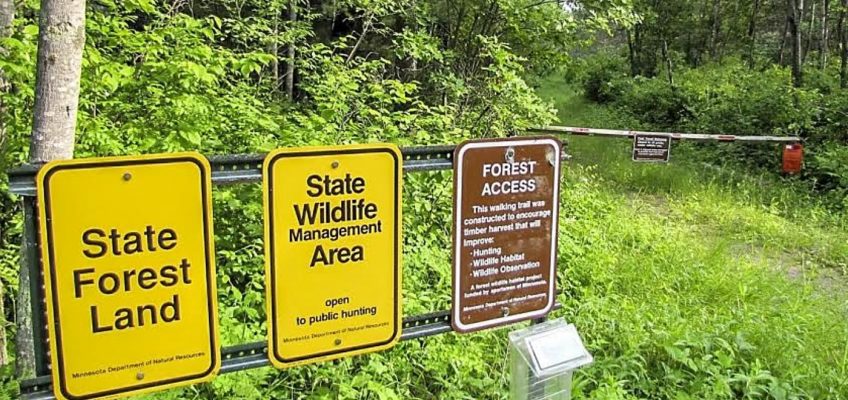Minnesota will get its share of federal sporting goods tax dollars after the U.S. Fish and Wildlife Service accepted changes in how the state plans and documents timber sales in state wildlife management areas.
In an Oct. 3 letter, federal officials notified Minnesota Department of Natural Resources Commissioner Sarah Strommen that they will release $4 million from the past budget cycle and $17.6 million from the current budget cycle to the DNR. The money is aimed at statewide wildlife habitat projects.
The federal agency had earlier withheld the state’s share of money because agency officials were concerned the DNR was offering timber sales on wildlife management areas that didn’t have a documented wildlife purpose filed in advance of the logging.
The U.S. Fish and Wildlife Service is releasing more than $21 million in wildlife habitat grants to the Minnesota Department of Natural Resources after reaching an agreement with the state agency over logging on wildlife management areas. (Amanda Odeski / Forum News Service)
The federal grants used to acquire, expand and manage wildlife areas come from excise taxes on hunting and fishing gear, and by law must be used to benefit wildlife habitat. Any management on those lands, including logging, must be done to benefit wildlife.
But now Charles Traxler, acting regional director of the U.S. Fish and Wildlife Service, says the DNR has moved to better document how and why the timber sales are done in wildlife areas.
“I am confident that future actions will comply with the grant and that there is a shared commitment to continue working together to improve grant management,” Traxler noted in the letter to the DNR.
The issue has been festering for more than four years as conservationists, including several current and retired DNR wildlife biologists, argue the DNR is planning to log too much and in the wrong places on some wildlife areas to benefit the timber industry, often to the detriment of wildlife habitat.
Pressured by those critics, the Fish and Wildlife Service stepped in and issued orders to the state, including a lengthy letter of agreement signed by both sides in March scolding the DNR for dragging its feet on the issue.
The March agreement stated that “desired future conditions (of the forest within management areas) will be based on sound wildlife biology and ecology principles” and that management plans for the wildlife and aquatic management areas will be consistent with federal legal requirements on how the lands are used.
In late June, three DNR timber sales on state wildlife management areas near Warroad were canceled just before they went up for auction. DNR officials later agreed to temporarily stop all such timber sales as requested by the Fish and Wildlife Service.
Craig Sterle, a former DNR forester who has helped lead the charge to call out the agency on wildlife area logging, said the agreement may mean the DNR is on the right track for managing areas for wildlife as they are intended.
“But we’ve been kept in the dark on any details agreed to behind the scenes, so we really don’t know,” Sterle said. “I’m hopeful that this will lead to real changes on the ground. But I think there are still concerns that these are just changes on paper that may not make any real difference in the woods.”
The dispute, first reported in the News Tribune in August 2019, began when top DNR officials began implementing a timber availability report that called for more trees to be cut on state lands to feed the state’s timber industry, including more timber from wildlife management areas.
The effort began under then Gov. Mark Dayton, and top DNR officials have continued to press for more logging under Gov. Tim Walz. The effort called for increasing the state’s share of wood for the industry from 800,000 cords annually to 870,000 cords, and asked for part of the increase to come from wildlife management areas.
In a 2019 letter to Strommen, 28 DNR wildlife managers described any industry-aimed increase in logging on wildlife areas as scientifically dishonest. They said concerns raised by wildlife staff were being ignored by DNR forestry staff and top DNR officials.
But Strommen said that, while wildlife area logging will be included as part of the total state timber sold to the timber industry, the agency has no quotas on how much timber must come from wildlife management areas. She continues to call critics’ complaints unwarranted and misguided, saying they have misunderstood the timber availability analysis from the start.
Minnesota has 1,440 public wildlife management areas totaling nearly 1.3 million acres, although only some of them are forested. The state has another 700 aquatic management areas covering some 700 miles of shoreline on lakes and rivers — much of it forested. Most of the state’s DNR-managed timber comes from state forests and is not subject to the issues over wildlife management areas.
Related Articles
Skywatch: The great autumn galactic happening
Gunfire from hunting can hurt hearing forever
There’s a moose on the loose in southern Minnesota
Skywatch: A Saturday solar eclipse
William O’Brien State Park gets major boost from longtime farmer Myron Lindgren


Leave a Reply